Giuseppe
VERDI (1813-1901)
A conspectus of his
life and a review of the audio and video
recordings of his works.
PART 3
Verdiís middle period:
The eight operas from Stiffelio (1850)
to Un ballo in Maschera (1859)
Part
1 Part
2 Part
4
By 1850, and following
the premiere of Luisa Miller in
Naples, the years that Verdi called
his Ďanni di galleraí (years in the
galleys) could finally be seen to be
over. However, the composer did, from
time to time, put himself under pressure
by leaving too little time to become
familiar with the characters of the
libretto plot and also compose the music.
His best and most successful future
operas were most often those whose subjects
he had mulled over for months or even
years.
Whilst in Naples for
Luisa Miller, Verdi had suggested
that Cammarano, the local librettist,
look at Victor Hugoís play Le Roi
síamuse as a suitable subject for
an opera. Verdi described the work as
a beautiful play with tremendous
dramatic situations. Back at Busseto
he followed this up with suggestions
that the librettist also look at Garcia
Gutiérezís Spanish play Il
Trovador. The composer also
sent the librettist a detailed synopsis
of King Lear. During this period
of debating his next opera Verdi was
offered the possibility of two Shakespearean
subjects. The first was an offer by
Benjamin Lumley, the London impresario,
of an opera based on The Tempest
and the second an actual libretto
of Hamlet. Verdi, with contracts
pressing considered that these, like
King Lear, were too complex for
the time available and he sought a subject
that was less demanding. He had after
all taken nearly a year over the composition
of Macbeth, his only Shakespeare-based
opera at that date.
Verdiís contracted
commitments were two. The first was
an opera for Ricordi, his publisher.
This was to be given in the autumn of
1850 in any Italian theatre of the publishers
choosing, except, at Verdiís continued
insistence, Milanís La Scala. The second
was for La Fenice in Venice. With time
pressing Verdi proposed four subjects
to the compliant Piave, including Le
Roi síamuse that he had already
suggested to Cammarano. Piave countered
with a list including Stiffelius,
based on a French play. The story concerns
a protestant minister whose wife commits
adultery in her husbandís absence and
who forgives her from the pulpit choosing
an apposite reading from the Bible.
It is a melodramatic story packed with
human emotions and inter-relationships
as well as dramatic situations. With
his success in conveying the intimate
relationships involved in La battaglia
di Legnano and Luisa Miller,
his previous two operas, Verdi felt
confident in his capacity to deal with
the story. He also badgered Piave to
study Victor Hugoís Le Roi síamuse;
the subject obviously captivated him.
With the Ricordi commission
pressing and placed at the Teatro Grande
in Trieste, Piave produced the libretto
of Stiffelio, Verdiís
16th opera quickly. The composer
spent the summer months of 1850 on the
work. The two travelled to Trieste for
the premiere and hit big opposition
from the Catholic Church who not only
objected to the concept of a priest
being a married man, but also that the
congregation were represented kneeling
in prayer! Further, Stiffelioís quotation
from The Sermon on the Mount,
as he publicly forgives his wife Lina
her adultery was forbidden, as was her
earlier address to her husband when
she appeals Ministro, ministro confessateri
(Minister, minister, hear my confession).
Verdi considered that the changes demanded
would emasculate the dramatic impact
of the whole plot. He agreed to compromises
with the censors as long as the
dramatic situation and the thrust of
his music were not affected. In other
circumstances and where compromise was
not possible, as will be seen with Un
Ballo in Maschera, he packed his
bags and took his opera elsewhere. With
Stiffelio having been placed
by Ricordi this was not open to him
despite his frustration and anger at
the necessary revisions. The premiere
was given on 16 November 1850 and was
well received with press comments such
as tender melodies follow one another
in a most attractive manner. All
the performances in Trieste were sold
out with the church scene omitted in
at least three of them. In staging in
other Italian cities Stiffelio was
re-titled Guglielmo Wellingrode,
its principal character no longer a
19th century protestant pastor,
but a Prime Minister of a German principality
in the early 15th century!
As the Verdi scholar Julian Budden notes
(Verdi, Master Musicians Series,
Dent. 1984) the composer was used to
having certain subjects rejected and
seeing his works bowdlerised when revived
in Naples and the Papal States. This
was the first time, however, that he
had suffered the mutilation of a work
at its premiere. He determined that
he would find a way of making it censor-proof.
He did so in 1856 when he had Piave
alter the locale and period of the work
whilst he himself made significant modifications
and additions to the music. The revised
opera was titled Aroldo and premiered
at the Teatro Nuovo, Rimini on 16 August
1857. It is dealt with below, as Verdiís
22nd title, in its appropriate
numerical sequence.
As was Verdiís habit
when revising a scene or aria in an
opera, he removed the revised or replaced
pages from the manuscript autograph.
To all intents and purposes, Stiffelio
ceased to exist in a performance
form complete with orchestration, although
vocal scores were available. In the
late 1960s orchestral parts for both
Stiffelio and its bowdlerised
version, Guglielmo Wellingrode,
came to light in the Naples Conservatory;
an integral performance of Stiffelio
became possible after one hundred
and fifteen years. This took place in
a performing edition by Rubin Profeta
in Parma on 26 December 1960 conducted
by Peter Maag. This is the basis of
the recording made by Philips in Vienna
in 1979 as part of their early Verdi
series under Lamberto Gardelliís idiomatic
direction (422-432-2).
At the 1850 premiere,
the role of Stiffelio was sung by the
tenor Gaetano Fraschini who had created
the roles of Zamero (Alzira),
Corrado (Il Corsaro), Arrigo
(La battaglia di Legnano) and
would go on to create Riccardo in Un
Ballo in Maschera. On the Philips
recording the role is taken with significant
dramatic thrust by José Carreras.
Sylvia Sass sings the adulterous wife
with full dramatic tone and involvement
in one of her rare assumptions on a
mainstream label. Matteo Manuguerra
is a little blustery as Stankar the
avenging father. Wladimiro Ganzarolli
is surprisingly firm as Stiffelioís
fellow priest as is Ezio Di Cesare as
the seducer of Lina; both roles are
shown as comprimario in the score. An
alternative live performance from Trieste
in December 2000, featuring Dimitra
Theodossiou as Lina and Giorgio Casciarri
in the title role, is available from
Dynamic (CDS 362/1-2). I have not heard
this performance but have read good
reports of it.
Stiffelio was
staged at Covent Garden in 1993 in the
manner Verdi intended. Carreras took
the eponymous role and the production,
seen on British TV, showed the opera
to be the dramatic and musically cohesive
work that Verdi knew he had created.
It was conducted by Edward Downes and
featured Catherine Malfitano as Lina.
In a later production at New Yorkís
Metropolitan Opera, Domingo sang the
name part. I believe the New York production
used a later edition with further newly
discovered music. Neither of these performances
has yet appeared on DVD although that
from Covent Garden circulates on the
pay-per-view satellite station Arts
World.
Verdi and Piave had
spent time together in Busseto during
the summer of 1850 when the libretto
of Stiffelio was finalised alongside
the opera from Victor Hugoís Le Roi
síamuse, called by them at this
stage La maledizione. Verdi was
greatly stimulated by La maledizione
and itched to start its composition;
he may have made significant sketches
during his work on Stiffelio.
He considered Victor Hugoís play Ďperhaps
the greatest drama of modern timesí
and the jester Tribolet, later to become
Rigoletto in his opera, Ďa creation
Ďworthy of Shakespeareí. In Verdiís
mind there could be no greater compliment.
Piave, a native of
Venice, had assured Verdi that the Austrian
censors of that city would not object
to the subject. On arrival in Venice
Verdi found that the censors did not
merely object to the subjectís immorality,
but also to such detail as a King being
involved, that Rigoletto was a hunchback
and that the body of his stabbed daughter
was on the stage, in a sack, in the
finale. Verdi packed his bags and returned
to Busseto. Piave tried to re-cast the
libretto to satisfy the censors, but
Verdi rejected his efforts outright,
considering that they nullified the
dramatic impetus and thrust of the story
and his composition. From Busseto he
wrote to the President of the La Fenice
offering a re-written ending to Stiffelio,
with himself being present as for a
new opera, in fulfilment of his contract
to provide a new composition for its
upcoming Carnival Season. Verdi also
informed Piave that the librettist would
not be paid the final part of his fee.
Verdi was not merely angry but in high
dudgeon.
With the Carnival Season
already underway, Piave and the secretary
of the La Fenice met the General Director
of Public Order who made a number of
concessions. The pair then hurried to
Busseto on 30 December. In a six point
document Verdi in his turn offered to
compromise on a Duke instead of a King,
but otherwise maintaining the original
characters of Victor Hugoís drama and
particularly a setting where the threat
of a curse was meaningful. He also maintained
the principle of Rigolettoís deformity
and the presence of the stabbed Gilda
in the final scene. The points were
accepted by the censor and Rigoletto,
Verdiís 17th opera opened
at the Teatro La Fenice, Venice on 11
March 1851 with Felice Varesi, creator
of Macbeth, in the title role.
Despite having to live
with his deformity that set him apart,
and which doubtless would have contributed
to his sense of grievance and bitter
tongue, Rigoletto is one of the
most profoundly human of Verdiís creations.
His character is defined in the music
of the great duets with his daughter
Gilda. The first, in act one, is of
fatherly love and concern, the second
is of fury as he discovers her defilement
by the Duke and the third of despair
as he opens the sack and she tells him
of her sacrificing of her life to save
the man who raped her yet whom she loves.
The vocal and histrionic demands of
the role have drawn every great high
baritone since its creation. A privileged
few have set down their interpretations
on record for posterity. To convey the
cloistered and virginal Gilda, Verdi
wrote the role for a light and flexible
soprano, a voice-type that is rare in
his works. To the rapacious Duke he
not only gave the memorable aria La
donne è mobile, destined
to become the most famous tenor aria
of all time, Nessun Dorma notwithstanding,
but also the opening phrases of the
most famous quartet in opera that follows,
both in the final act. The Duke is one
of the most gracefully lyrical of all
Verdiís tenor roles, which might be
seen in some way as compensating for
the vileness of his character.
As far as recordings
are concerned and for the first time
in the Verdi canon, there is plenty
of choice in both the audio and visual
medium. With the advent of the LP each
of the major recording companies issued
a mono recording with their contracted
artists. In the home of my youth in
this period the focus was on the portrayal
of Rigoletto himself. Our choice was
between the superbly biting and incisive
dramatic portrayal of Tito Gobbi on
Columbia (later EMI) under Serafin and
the equally impressive but more rounded
tones of Giuseppe Taddei from the Italian
Cetra company. The presence of Tagliavini
as the Duke tipped our choice Cetraís
way, he being far preferable to the
less elegant Di Stefano. Lina Pagliughi,
very experienced in the part on stage,
sounds somewhat mature for the role
and is rather thin-toned. We preferred
that to Callas on the Columbia issue.
In a role that she only ever sang twice
on stage, Callas fails to represent
the virginal naivety of Gilda. Her Caro
nome is lacking in spontaneity giving
an impression of artifice. There is
dramatic compensation in her duets with
Gobbi, particularly tutte le feste
in act two. At the time of writing the
Gobbi recording with Callas is available
from EMI although not yet at a price
commensurate with its age. However,
Regis have promised a bargain priced
version derived from LP sources. EMI,
holders of the master tapes, may follow
suit in their ĎClassics Seriesí in the
same  realistic
price bracket.The Cetra performance
is already available at bargain price
from Warner Fonit (review).
realistic
price bracket.The Cetra performance
is already available at bargain price
from Warner Fonit (review).
With the advent of
stereo the recording majors went on
the roundabout again. An early stereo
success was scored by RCA. It featured
Robert Merrill as a dark-toned vocally
smooth Rigoletto alongside the elegantly
phrased Duke of Alfredo Krauss and with
Anna Moffoís lyrical  coloratura
Gilda being one of the best on record.
Solti, on loan from Decca, drives
the drama hard but effectively (review).
Regrettably, minor cuts in the score
are a drawback. In 1971 Decca recorded
an absolutely complete edition. They
fielded the young Pavarotti singing
with open-throated ardour, excellent
phrasing and characterisation as the
Duke. The featured Rigoletto is again
an American, Sherrill Milnes, who sings
powerfully and expressively. In her
second recording of Gilda for Decca,
Joan Sutherland sounds rather matronly
and her poor diction is a drawback to
set against the security of her coloratura
and florid singing. The quality of the
recording is excellent as is Bonyngeís
sympathetic conducting. Not to be missed
is Talvela in the minor bass role of
Sparafucile, the assassin; hear his
low note as he leaves Rigoletto in the
alleyway near the latterís home (Decca
414 269 2). Some commentators find virtue
in Giuliniís detailed conducting on
the 1980 recording (DG 457 453 2). Cappuccilli,
whilst singing in long-breathed phrases,
doesnít convey, to my ears, the agony
that Rigoletto goes through in the course
of the opera. Ileana Cotrubas as Gilda
is not ideally secure at the top of
her voice whilst Domingo as the Duke
is strong vocally but bland in characterisation.
What Cappuccilli lacks in characterisation,
Renato Bruson has in abundance under
Sinopoli (Philips 462 158 2). The Gilda
of Edita Gruberova is vocally secure
if lacking in tonal beauty and variety,
as is Shicoff as the Duke.
coloratura
Gilda being one of the best on record.
Solti, on loan from Decca, drives
the drama hard but effectively (review).
Regrettably, minor cuts in the score
are a drawback. In 1971 Decca recorded
an absolutely complete edition. They
fielded the young Pavarotti singing
with open-throated ardour, excellent
phrasing and characterisation as the
Duke. The featured Rigoletto is again
an American, Sherrill Milnes, who sings
powerfully and expressively. In her
second recording of Gilda for Decca,
Joan Sutherland sounds rather matronly
and her poor diction is a drawback to
set against the security of her coloratura
and florid singing. The quality of the
recording is excellent as is Bonyngeís
sympathetic conducting. Not to be missed
is Talvela in the minor bass role of
Sparafucile, the assassin; hear his
low note as he leaves Rigoletto in the
alleyway near the latterís home (Decca
414 269 2). Some commentators find virtue
in Giuliniís detailed conducting on
the 1980 recording (DG 457 453 2). Cappuccilli,
whilst singing in long-breathed phrases,
doesnít convey, to my ears, the agony
that Rigoletto goes through in the course
of the opera. Ileana Cotrubas as Gilda
is not ideally secure at the top of
her voice whilst Domingo as the Duke
is strong vocally but bland in characterisation.
What Cappuccilli lacks in characterisation,
Renato Bruson has in abundance under
Sinopoli (Philips 462 158 2). The Gilda
of Edita Gruberova is vocally secure
if lacking in tonal beauty and variety,
as is Shicoff as the Duke.
As far as audio recordings
are concerned, my greatest regret is
that the most elegantly sung Duke, that
by Carlo Bergonzi, is paired with the
most unidiomatic Rigoletto of ones nightmares,
Fischer-Dieskau, on an early 1960s recording
conducted by Kempe (DG). My colleague
GF in his review of the Solti set also
surveys contemporaneous issues and is
far more sympathetic to Fischer-Dieskauís
interpretation than I. However, Bergonziís
singing of the Dukeís major arias from
this recording, together with a brief
extract from the act 2 scene where the
courtiers tell the Duke of their abduction
and also the quartet, are included on
the two disc selection Carlo Bergonzi.
The Sublime Voice (Decca 467 023-2).
On DVD there is choice
to suit ones particular tastes as to
production style. David McVicarís 2002
Covent Garden production includes Marcelo
Álvarezís robust Duke alongside
Paolas Gavanelliís powerfully acted
and sung Rigoletto. Edward Downes on
the rostrum brings out every nuance
in the music. The costumes are in period
with modernistic representational sets
and plenty of Rabelaisian activity in
the first scene (BBC/Opus Arte 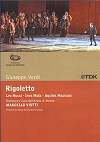 OA0829D).
The sparsely set Verona performance
of 2001 with Nucci as Rigoletto has
OA0829D).
The sparsely set Verona performance
of 2001 with Nucci as Rigoletto has
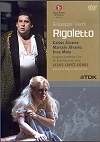 recently
been re-issued at mid-price. (TDK DV-OPRIGM
[right]). A colleagueís original review
can be found at here.
Marcelo Álvarezís Duke also features
in the December 2004 Gran Teatre del
Liceu, Barcelona, recording with Carlos
Álvarez not ideally steady in
the title role (review).
Of older recordings, in the Met
production of 1977 John Dexter took
the paintings of the Venetian painter
Giorgione as a starting point. This
is a typical traditional Met production
with naturalistic sets and costumes
appropriate to the period that Verdi
sought for his opera. The performance
features a lyric-voiced young Domingo
as the Duke, a vividly acted if a little
dry-toned Rigoletto from then veteran
American baritone Cornell MacNeil and
an affecting Gilda from Ileana Cotrubas.
Both the tenor and soprano far surpass
their performances for Giulini on CD.
The colours have
recently
been re-issued at mid-price. (TDK DV-OPRIGM
[right]). A colleagueís original review
can be found at here.
Marcelo Álvarezís Duke also features
in the December 2004 Gran Teatre del
Liceu, Barcelona, recording with Carlos
Álvarez not ideally steady in
the title role (review).
Of older recordings, in the Met
production of 1977 John Dexter took
the paintings of the Venetian painter
Giorgione as a starting point. This
is a typical traditional Met production
with naturalistic sets and costumes
appropriate to the period that Verdi
sought for his opera. The performance
features a lyric-voiced young Domingo
as the Duke, a vividly acted if a little
dry-toned Rigoletto from then veteran
American baritone Cornell MacNeil and
an affecting Gilda from Ileana Cotrubas.
Both the tenor and soprano far surpass
their performances for Giulini on CD.
The colours have 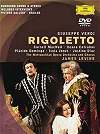 come
up amazingly well, but the orchestra
is set rather too distantly and loses
some dramatic impact, a situation not
helped by Levineís relaxed interpretation
(DG 073 093 9) (review).
Pavarotti fans will find his Duke on
Jean-Pierre Ponnelleís film of the opera.
It is in period costume and with location
shots interspersed with some unusual
stage scenes. The Rigoletto of the Scandinavian
baritone Ingvar Wixell, with his stocky
stature and chubby cheeks, fails to
convince me visually. This has been
reissued on DG (00440 073 4166) having
previously appeared on the Decca label.
Taking sound and picture quality into
consideration, I find the Covent Garden
performance particularly satisfying,
although some may find the portrayal
of various simulated sexual activities
in the opening scene a bit raunchy.
Marcelo Álvarez is always going
to be a bit wooden in his acting, but
the sound is better balanced and hasnít
the slightly hard edge of the Barcelona
performance which accentuates the voices
at the expense of the orchestra.
come
up amazingly well, but the orchestra
is set rather too distantly and loses
some dramatic impact, a situation not
helped by Levineís relaxed interpretation
(DG 073 093 9) (review).
Pavarotti fans will find his Duke on
Jean-Pierre Ponnelleís film of the opera.
It is in period costume and with location
shots interspersed with some unusual
stage scenes. The Rigoletto of the Scandinavian
baritone Ingvar Wixell, with his stocky
stature and chubby cheeks, fails to
convince me visually. This has been
reissued on DG (00440 073 4166) having
previously appeared on the Decca label.
Taking sound and picture quality into
consideration, I find the Covent Garden
performance particularly satisfying,
although some may find the portrayal
of various simulated sexual activities
in the opening scene a bit raunchy.
Marcelo Álvarez is always going
to be a bit wooden in his acting, but
the sound is better balanced and hasnít
the slightly hard edge of the Barcelona
performance which accentuates the voices
at the expense of the orchestra.
From the start Rigoletto
was popular with audiences although
the censors, especially in the Papal
States, did their best to emasculate
it. In Naples it appeared as Clara
de Perth with an altered text. Despite
the virtues of its immediate successor
operas, Il Trovatore and La
Traviata, it was a long time before
Verdi surpassed Rigoletto in
compositional density of invention.
As to the role of Rigoletto himself,
Budden (The Operas of Verdi. Vol. 1)
puts it succinctly when he states The
name part of Rigoletto remains the greatest
part ever written for a high baritone,
by requiring every emotional stop of
which the voice is capable. At the
age of 38, Verdi had put his own stamp
and a new face on Italian opera. The
period of the ottocento was finished.
Verdiís Rigoletto did for Italian
opera what Beethovenís Eroica had
done for the symphony fifty years earlier;
it moved the genre along a significantly
new path. There would be regressions
along the way, but the new direction
was clear.
After the third performance
of Rigoletto, Verdi left Venice
for Busseto and Giuseppina. The notoriety
of the subjects of his last two operas,
Stiffelio and Rigoletto,
followed him into the rather puritanical
provincial countryside. The pair moved
into the property at SantíAgata. This
involved Verdi moving his parents into
another property, his father having
been a poor manager of the farm. To
compound matters Verdiís mother died
in the June. The questioning among the
locals grew as to why Verdi had brought
Giuseppina to Busseto without the benefit
of marriage. To Verdiís disgust they
considered her a loose woman and ostracised
her at church. Shortly after the couple
had retreated to Paris for the winter
of 1851-52 Verdi received a letter from
Barezzi, the father of his deceased
wife and whose beneficence had been
essential in the composerís early studies
and life. The letter questioned Verdi
as to his relationship with Giuseppina.
Verdi revered Barezzi and was hurt to
the core. He replied at length without
answering the points raised. It says
much about the relationship between
the pair that Barezzi accepted it and
was soon on excellent terms with Giuseppina
as well as Verdi himself. As to why
the pair did not marry is not known.
They had been living together for four
years and she was his wife in all but
name.
These domestic matters
in Busseto took Verdiís mind off his
next operatic project for some months.
He had written to Cammarano from Venice,
shortly before the premiere of Rigoletto
in March 1851, proposing the subject
of Garcia Gutiérezís Spanish
play Il Trovador. The idea of
two female roles in the play appealed
to Verdi, particularly the character
of the gypsy woman who he described
as a strange woman after whom I want
to name the opera, Back at Busseto
he followed this up with suggestions
that the librettist also look at Garcia
Gutiérezís Spanish play Il
Trovador. The composer
perhaps saw her as the female counterpart
of Rigoletto. Cammarano was dilatory
in replying and was full of objections
when he did so. Verdiís response was
that the drama offered fine theatrical
effects and above all something original
and out of the ordinary. He further
urged his librettist to be free and
innovative in form, strictures really
beyond Cammaranoís capabilities. In
the end Verdi was forced to send his
own synopsis of the action and this
is in large measure the form in which
we know the opera Il Trovatore.
When Naples found Verdiís fee too steep
for their cash-strapped situation, he
proposed the opera be premiered in Rome
if the censors accepted Cammaranoís
libretto. At that point Verdi learned,
through a friend, of Cammaranoís death.
The Young poet Emmanuele Bardare, who
had converted Rigoletto into
Clara di Perth for Naples, undertook
the completion of the libretto. Verdi
paid Cammaranoís widow the full fee,
plus a premium, as she was poorly provided
for.
The various additions
to the libretto of Il Trovatore required
of Bardare show Verdiís intent on a
two-diva opera, with the voices concerned
being of distinctly different ranges
and colour. Needless to say the censor
quibbled about details. The Ďstakeí
might be too vivid a reminder of the
Inquisition and the words of the Miserere
were altered, as strict Liturgical phrases
were not allowed. With these relatively
minor problems sorted Il Trovatore,
Verdiís 18th opera, was premiered
at the Teatro Apollo, Rome, on 19 January
1853. It was a resounding triumph with
the final scene being encored in its
entirety. There were odd cavils about
the gloomy subject and the number of
deaths. The opera spread rapidly and
was even parodied with baby swapping
figures in two of Gilbert and Sullivanís
most popular works. Charles Osborne
(Verdi. A life in the theatre)
suggests that Il Trovatore, with
its wealth of melody, dark orchestral
colouring and almost brutal vigour is
the height of Italian romantic opera
and the apotheosis of the bel canto
tradition with its concern only
for vocal beauty, agility and range.
Whilst those bel canto virtues
are demanded in Il Trovatore,
the thrust and dynamism as well as the
tinta of the music call for distinctly
bigger voices than Verdiís earlier operas
or the works of other composers had
needed previously. The baritone singer
of Rigoletto or Miller will
generally encompass the role of Di Luna
with ease. The same cannot be said of
the tenor role of Manrico in Il Trovatore
compared with the Duke in Rigoletto
or Rodolfo in Luisa Miller or
indeed of any of the tenor roles in
the composerís previous works. The role
of Leonora, which Verdi filled out for
a prima donna voice, demands flexibility
in coloratura and the dynamic range
and colour of a dramatic soprano. But
it is the role of the gypsy Azucena
that really marks out the opera. Verdi
had never previously written so full
and dominant a role for contralto or
dramatic mezzo voice. It was to be the
first of a series of memorable roles
in his succeeding operas for the voice
type. The vocal demands on the cast
of Il Trovatore caused the great
tenor Enrico Caruso to suggest that
all that is needed for a performance
are the four greatest singers in
the world.
Carusoís opinion of
the quality of singers required for
a performance of Il Trovatore might
be fairly near the mark. The problem
in the early years of the LP record
was that the singers most capable of
realising the dream recording were often
under contract to different recording
companies in an era when an exclusive
contract meant that. Despite those limitations,
later relaxed, there is plenty of choice
available of good audio performances
going all the way back to the early
days of mono LPs to the recent digital
era. RCA was in early with a Met-based
cast that has some fine, even old-fashioned,
Verdi spinto singing  from
the redoubtable Zinka Milanov as Leonora.
Her colleagues are some of the best
around at the time, Jussi Björling
as an elegant Manrico, Leonard Warren
strong-toned as Di Luna whilst Fedora
Barbieri is formidable as Azucena. Regrettably
the performance is subject to the severe
performance cuts common at the time
(review).
Barbieri repeats her interpretation
of Azucena under
from
the redoubtable Zinka Milanov as Leonora.
Her colleagues are some of the best
around at the time, Jussi Björling
as an elegant Manrico, Leonard Warren
strong-toned as Di Luna whilst Fedora
Barbieri is formidable as Azucena. Regrettably
the performance is subject to the severe
performance cuts common at the time
(review).
Barbieri repeats her interpretation
of Azucena under  Karajan
in the1957 recording from La Scala with
Callas, Di Stefano and Panerai as colleagues
(review).
Karajan opened up many of the traditional
cuts and is a dynamic conductor. This
performance is now available in EMI's
Great Recordings of the
Karajan
in the1957 recording from La Scala with
Callas, Di Stefano and Panerai as colleagues
(review).
Karajan opened up many of the traditional
cuts and is a dynamic conductor. This
performance is now available in EMI's
Great Recordings of the  Century
series, with libretto and translation,
and at bargain price with track-listing
and related synopsis only (review).
The early stereo era saw two outstanding
versions. The first in 1962, again based
on La Scala, is conducted with a touch
too much affection by Tullio Serafin.
Its great virtue is that it is blest
with an all-Italian cast to join the
vibrant La Scala chorus. Notable are
Carlo Bergonzi as Manrico and the young
Fiorenza Cossotto as Azucena. (DG 453
118-2). In 1969 RCA scored a triumph
with Il Trovatore in a London-based
recording of the full score, as was
then the habit. Leontyne Price is an
incomparable Leonora, the young Domingo
a virile Manrico with Cossotto, again,
and Sherrill Milnes completing a fine
quartet of soloists. Zubin Mehtaís conducting
and a clear recording leaves this performance
very high on the recommended list (RCA
74321 39504-2). I was fortunate to see
and hear Cossottoís portrayal of Azucena
in the theatre. Her acting matched the
thrilling vitality of her singing to
give me one of the greatest Verdi interpretations
to come my way in fifty years of opera-going.
The flip-side was seeing Leontyne Price
as Leonora. Her opulent tones and ability
with a Verdian phrase were a delight,
but she brought her own costume and
walked through the part.
Century
series, with libretto and translation,
and at bargain price with track-listing
and related synopsis only (review).
The early stereo era saw two outstanding
versions. The first in 1962, again based
on La Scala, is conducted with a touch
too much affection by Tullio Serafin.
Its great virtue is that it is blest
with an all-Italian cast to join the
vibrant La Scala chorus. Notable are
Carlo Bergonzi as Manrico and the young
Fiorenza Cossotto as Azucena. (DG 453
118-2). In 1969 RCA scored a triumph
with Il Trovatore in a London-based
recording of the full score, as was
then the habit. Leontyne Price is an
incomparable Leonora, the young Domingo
a virile Manrico with Cossotto, again,
and Sherrill Milnes completing a fine
quartet of soloists. Zubin Mehtaís conducting
and a clear recording leaves this performance
very high on the recommended list (RCA
74321 39504-2). I was fortunate to see
and hear Cossottoís portrayal of Azucena
in the theatre. Her acting matched the
thrilling vitality of her singing to
give me one of the greatest Verdi interpretations
to come my way in fifty years of opera-going.
The flip-side was seeing Leontyne Price
as Leonora. Her opulent tones and ability
with a Verdian phrase were a delight,
but she brought her own costume and
walked through the part.
Placido Domingo repeated
his recorded assumption of Manrico in
Giuliniís 1984 recording of Il Trovatore.
With many portrayals of Otello to his
credit he is in fuller voice than on
the earlier RCA issue, but with some
slight loss of lyrical ardour. Rosalind
Plowright matches Domingoís vocal strength
whilst Zancanaro as Luna sings with
fine legato and elegant phrasing. The
growing dearth of Verdi voices is exemplified
by the casting of Brigitte Fassbaender
as Azucena. More used to singing the
likes of Orlofsky in Die Fledermaus,
she had never sung the role on stage
and cannot match either the Verdian
patina or Italianata of her colleagues
or recorded rivals. I personally find
Giuliniís conducting rather studied
and lacking in spontaneity (DG 423 858-2).
EMI recorded their then golden  couple
of Roberto Alagna and Angela Gheorghiu
as the lovers in 2001. She is lovely
to listen to, but lacks characterisation
whilst his throaty emission does nothing
for Manrico. Thomas Hampson sings well
as Luna whilst the Russian Larissa Diadkova
is a strong Azucena. (review).
For Pavarotti fans the news is not good
as far as audio versions are concerned.
Neither of his recordings for Decca
have much to recommend them. I also
find too many vocal limitations in the
Sony recording of 2000 under Muti (S2K
89553), whilst Andrea Bocelliís efforts
owe more to subtle engineering than
his spinto abilities. His voice is reedy
and lacking in variety of colour. He
also lacks a sense of Verdian phrasing
in this opera (Decca 475 366-2).
couple
of Roberto Alagna and Angela Gheorghiu
as the lovers in 2001. She is lovely
to listen to, but lacks characterisation
whilst his throaty emission does nothing
for Manrico. Thomas Hampson sings well
as Luna whilst the Russian Larissa Diadkova
is a strong Azucena. (review).
For Pavarotti fans the news is not good
as far as audio versions are concerned.
Neither of his recordings for Decca
have much to recommend them. I also
find too many vocal limitations in the
Sony recording of 2000 under Muti (S2K
89553), whilst Andrea Bocelliís efforts
owe more to subtle engineering than
his spinto abilities. His voice is reedy
and lacking in variety of colour. He
also lacks a sense of Verdian phrasing
in this opera (Decca 475 366-2).
If Pavarotti fans really
cannot do without their own favourite
tenorís interpretation of a role famous
for its high C, the DVD market is their
answer with the tenor singing in a traditional
Met production conducted with verve
by Levine. Both the production and the
tenor are a bit static. His rather portly
figure and wooden acting do not make
for the ideal troubadour whilst Eva
Marton as Leonora is a little heavy
vocally and Sherrill Milnes as Luna
is unusually variable. Dolores Zajick
as Azucena is on a par with the great
Italian mezzos who have essayed the
role with distinction (DG 073 002 9).
My favourite Azucena, Fiorenza Cossotto,
gives a characteristically vivid portrayal
on the 1985 recording from Verona. Alongside
her, Rosalind Plowright is excellent
as Leonora and Giorgio Zancanaro is
a visually and tonally elegant Luna.
Franco Bonisolliís Manrico is from the
can belto school; viscerally
exciting and the audience love it, but
if you have perfect pitch you might
not. It was Bonisolli who sulked out
of Karajanís last recorded effort when
the conductor returned to the Vienna
State Opera in 1978. By the greatest
good luck Domingo was available and
jetted in. His thrillingly acted and
sung portrayal, no unwritten notes or
any 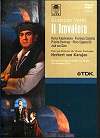 held
indecently long from him, is matched
by Raina Kabaivanskaís Leonora and Pierro
Cappuccilliís long-breathed Italianate
Luna. Fiorenza Cossotto repeats her
memorable Azucena. The old maestro Karajan
may have lost something of the dramatic
bite of his La Scala audio recording
of thirty years earlier, just re-issued
by EMI, but he still has the right feel
for the work and a Verdian phrase. Regrettably
Karajan makes a couple of cuts and the
Vienna audience applaud frequently and
loudly (review).
held
indecently long from him, is matched
by Raina Kabaivanskaís Leonora and Pierro
Cappuccilliís long-breathed Italianate
Luna. Fiorenza Cossotto repeats her
memorable Azucena. The old maestro Karajan
may have lost something of the dramatic
bite of his La Scala audio recording
of thirty years earlier, just re-issued
by EMI, but he still has the right feel
for the work and a Verdian phrase. Regrettably
Karajan makes a couple of cuts and the
Vienna audience applaud frequently and
loudly (review).
A few years prior to
the composition of Rigoletto,
Verdi often complained of the pressures
on him and he frequently suffered psychosomatic
illness as a consequence. After Rigoletto,
and his fame assured, he could, both
artistically and financially have afforded
to relax and Giuseppina appealed to
him to do so. His artistic drive allowed
no such luxury. Initially Il Trovatore
had no agreed theatre or date for
its production. Verdi agreed its premiere
for Rome, but this was delayed by the
death of Cammarano. Meanwhile, in April
1852, following a visit by Brenna, secretary
of La Fenice, Verdi agreed to present
an opera at that theatre in March of
the following year. Also, whilst in
Paris he had accepted a commission for
an entirely new work for The Opéra
to coincide with the Paris Exhibition
of 1855. Whilst on that visit to Paris
he had seen and been impressed by Alexander
Dumasís semi-autobiographical play La
Dame aux caméllias based
on the novel of the same name. Whilst
it was agreed that Piave would be the
librettist for the La Fenice opera,
no choice of subject was made. Verdi
put off the choice until the preceding
autumn, worrying the theatre about the
available singers. The theatre in their
turn wanted to get the censorís approval
of the subject to satisfy their own
peace of mind. Piave produced at least
one libretto, which Verdi turned down,
before the composer settled on the Dumas
play. The opera was titled La
Traviata; it was his 19th
opera. After Stiffelio it was Verdiís
most contemporary subject.
At the very least the
first act of La Traviata was
composed contemporaneously with the
later and amended portions of Il
Trovatore, operas wholly different
in musical mood and key register. The
delay in the premiere of Il Trovatore,
brought about by the death of the original
librettist Cammarano, and the necessity
for new verse from Emmanuele Bardare,
meant that Verdi had only six weeks
between the premieres of the two operas.
He had spent the winter worrying about
the suitability of the soprano scheduled
to sing the consumptive Violetta. He
was also upset that the La Fenice decided
to set his contemporary subject in Louis
XVI period, around 1700, thus losing
the immediacy and relevance that he
intended for the audience.
Verdi was correct in
worrying about the singers. At the end
of act 1, with its florid coloratura
singing he was called to the stage.
The audience was less sympathetic to
the portly soprano portraying a dying
consumptive in the last act and laughed
loudly. The tenor singing Alfredo was
poor and Varesi, who had premiered both
Macbeth and Rigoletto, considered Germont
below his dignity and made little effort.
Verdi himself considered the premiere
a fiasco. He did, however, compliment
the players of the orchestra who had
realised his beautifully expressive
writing for strings, not least in the
preludes to acts 1 and 3. Although other
theatres wished to stage La Traviata,
he withdrew the opera until he was satisfied
that any theatre concerned would cast
the three principal roles for both vocal
and acting ability. The administrator
of Veniceís smaller San Benedetto theatre
undertook to meet Verdiís demands. He
promised as many rehearsals as the composer
wanted and to present the opera with
the same staging and costumes as at
the La Fenice premiere. Verdi revised
five numbers in the score and on 6 May
1854 La Traviata was acclaimed
with wild enthusiasm in the same city
where it had earlier been a fiasco.
Verdi was well pleased both by the success,
and particularly the circumstances and
location.
La Traviata is
now recognised not only as one of Verdiís
finest operas, but one of the lyric
theatreís greatest music-dramas. Its
vocal demands on the eponymous heroine
are considerable and diverse between
the three acts. The first act demands
vocal lightness and coloratura flexibility
whist the second act needs a lyrical
voice capable of wide expression and
some power. But in act three Violetta
needs not only the power of a lyrico-spinto
voice, but also colour and dramatic
intensity as well as a histrionic ability
beyond many singers. These qualities
are particularly needed as Violetta
recites the poignant phrases in Teneste
la promessa (You have kept your
promise) as she reads Germontís letter
indicating Alfredoís return and Addio
del passato as she realises itís
all too late. Violetta has then to express
her joy at seeing Alfredo before colouring
her voice as she gives him a portrait
of herself to pass to the virgin he
will marry before finally raising herself
from her bed for one vocal outburst
as she collapses and dies in his arms.
From the earliest days
of audio recording the role of Violetta
in La Traviata has drawn the
greatest sopranos of their generation
to set down their interpretations. In
the days of 78s Rosa Ponselle set the
highest standard (Naxos 8.110 032/3)
whilst in the age of LP Maria  Callasís
recordings from the 1950s have induced
much critical debate. Her only studio
recording was made in 1953 for Cetra,
now re-mastered by Naxos (review).
In this performance her singing is freshly
voiced, whilst her interpretation of
the florid music of the first act, the
lyricism of the second and the drama
of the third is superbly portrayed.
Her other recorded performances derive
from live occasions at La Scala in 1955
with Giulini conducting (EMI CMS 6 66450-2)
and Lisbon under Ghione (EMI CDS 5 56330-2).
Both these recordings have Callas singing
with quality colleagues, unlike on the
Cetra recording, but both suffer from
stage noises and inferior sound. It
also has to be said that the diva shows
some vocal deterioration by the time
of the second of those live performances
despite a highly admired histrionic
interpretation.
Callasís
recordings from the 1950s have induced
much critical debate. Her only studio
recording was made in 1953 for Cetra,
now re-mastered by Naxos (review).
In this performance her singing is freshly
voiced, whilst her interpretation of
the florid music of the first act, the
lyricism of the second and the drama
of the third is superbly portrayed.
Her other recorded performances derive
from live occasions at La Scala in 1955
with Giulini conducting (EMI CMS 6 66450-2)
and Lisbon under Ghione (EMI CDS 5 56330-2).
Both these recordings have Callas singing
with quality colleagues, unlike on the
Cetra recording, but both suffer from
stage noises and inferior sound. It
also has to be said that the diva shows
some vocal deterioration by the time
of the second of those live performances
despite a highly admired histrionic
interpretation.
As to stereo recordings
of La Traviata, my latest count
shows in excess of twenty. I personally
continue to be fond of Joan Sutherlandís
first recording made in 1962. She is
in fresh voice although her diction
could be better. A major appeal of this
recording is its completeness; all cabalettas
and verses are included. Another joy
is Carlo Bergonziís wonderful tone,
phrasing and legato as Alfredo (Decca
470 440-2 and as a Double Decca on 460
759-2). Fortunately for the recorded
legacy Bergonziís quality interpretation
is repeated with his presence on the
1967 RCA recording alongside Montserrat
Caballéís  affecting
Violetta and Sherrill Milnes as an impressive
Germont. For sheer beauty of vocalisation
of Verdiís score this recording takes
some beating, but it is let down by
Prêtreís conducting (review).
RCAís earlier, 1960 recording, features
Anna Moffo in her signature role. It
has been reissued in superbly re-mastered
and hybrid SACD/CD form. The recording
sounds better than it ever did on LP
or on earlier CD issues. It suffers
the theatre cuts common at the time
and the diva lacks the vocal
affecting
Violetta and Sherrill Milnes as an impressive
Germont. For sheer beauty of vocalisation
of Verdiís score this recording takes
some beating, but it is let down by
Prêtreís conducting (review).
RCAís earlier, 1960 recording, features
Anna Moffo in her signature role. It
has been reissued in superbly re-mastered
and hybrid SACD/CD form. The recording
sounds better than it ever did on LP
or on earlier CD issues. It suffers
the theatre cuts common at the time
and the diva lacks the vocal  vitality
that others convey. Richard Tucker as
Alfredo is no match for Bergonzi or
Domingo (review).
What Prêtre lacks as a conductor
both in supporting his singers and conveying
the pathos in the preludes and last
act, Carlos Kleiber has in profusion
in his 1977 recording with Ileana Cotrubas
a fragile and affecting Violetta and
Domingo an ardent Alfredo; Milnes reprises
his fine Germont (DG 445 469-2).
vitality
that others convey. Richard Tucker as
Alfredo is no match for Bergonzi or
Domingo (review).
What Prêtre lacks as a conductor
both in supporting his singers and conveying
the pathos in the preludes and last
act, Carlos Kleiber has in profusion
in his 1977 recording with Ileana Cotrubas
a fragile and affecting Violetta and
Domingo an ardent Alfredo; Milnes reprises
his fine Germont (DG 445 469-2).
Pavarotti fans had
to wait for a recording of his Alfredo
until Deccaís 1980 digital recording
with Sutherland by a then too matronly
Violetta and Manuguerra a coarse Germont
(430 491-2). He did get the opportunity
to reprise the role in 1991 alongside
the Violetta of Cheryl Studer under
James Levineís baton and recorded in
the Manhattan Center, New York with
the Met orchestra and chorus, all well
caught (DG 435 797-2). Although Studer
had not at that time sung the role on
stage, she gives an appealing, vocally
secure and distinctive rendering in
all three acts. Pavarotti still has
plenty of sap in his tone alongside
the addition of some vocal coarseness.
A sixty-five minutesí long highlights
CD had the virtue of limiting Juan Ponsí
monochromic and flaccid Germont (DG
437 726-2). Three years later, reviews
of Richard Eyreís production at Londonís
Covent Garden, featuring Angela Gheorghiuís
debut as Violetta and Solti conducting
his first ever La Traviata,
caused the BBC to alter their schedules
to transmit a performance. Gheorghiu
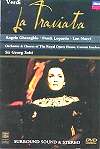 looks,
sings and acts wonderfully, albeit somewhat
carefully in the act 1 coloratura. Her
presence on stage for most of the opera
vitiates Frank Lopardoís penny-plain
Alfredo and Leo Nucciís stiff Germont.
Available in both audio (Decca 448 119-2)
and DVD formats (review)
it is, in my view, a performance better
seen than merely heard. Other favourite
sopranos who are worth hearing as Violetta,
and at super bargain price, include
Victoria de los Angeles
looks,
sings and acts wonderfully, albeit somewhat
carefully in the act 1 coloratura. Her
presence on stage for most of the opera
vitiates Frank Lopardoís penny-plain
Alfredo and Leo Nucciís stiff Germont.
Available in both audio (Decca 448 119-2)
and DVD formats (review)
it is, in my view, a performance better
seen than merely heard. Other favourite
sopranos who are worth hearing as Violetta,
and at super bargain price, include
Victoria de los Angeles
(review)
and Mirella Freni (review).
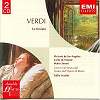 |
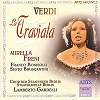 |
Universal, on their
DG label, have followed the earlier
Decca example of issuing a live performance
in both audio and video formats with
the recording of the latest wonder couple,
Anna Netrebko and Rolando Villazón,
as the lovers in Willy Deckerís modern
dress minimalist staging from the 2005
Salzburg Festival. Although Netrebkoís
coloratura in act 1 could be better,
hers is a visually attractive and vibrantly
acted Violetta whilst Villazónís
Alfredo is an outstanding histrionic
interpretation. Thomas Hampsonís wooden
 acting
and inexpressive singing as Germont
is a drawback. The physicality and vibrancy
of the acting of the two lovers make
this performance better seen than heard
despite the production idiosyncrasies
and sparse sets. (review).
When La Gheorghiu made a temperamental
withdrawal from Pier Luigi Pizziís 2003
production at Madridís Teatro Real,
it gave Parisian Norah Ansellem her
big chance and she has gone on to reprise
her interpretation at some of the best
addresses. The split-stage used by the
producer
acting
and inexpressive singing as Germont
is a drawback. The physicality and vibrancy
of the acting of the two lovers make
this performance better seen than heard
despite the production idiosyncrasies
and sparse sets. (review).
When La Gheorghiu made a temperamental
withdrawal from Pier Luigi Pizziís 2003
production at Madridís Teatro Real,
it gave Parisian Norah Ansellem her
big chance and she has gone on to reprise
her interpretation at some of the best
addresses. The split-stage used by the
producer 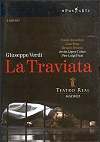 raises
more questions than issues it illuminates,
at least as far as the DVD is concerned.
Supposedly set in Second World War Paris,
the odd Nazi uniform passes with barely
a notice. José Bros is more than
adequate as Alfredo, whilst Renato Brusonís
Germont, well past his vocal sell-by
date, is a superbly acted portrayal
(review).
raises
more questions than issues it illuminates,
at least as far as the DVD is concerned.
Supposedly set in Second World War Paris,
the odd Nazi uniform passes with barely
a notice. José Bros is more than
adequate as Alfredo, whilst Renato Brusonís
Germont, well past his vocal sell-by
date, is a superbly acted portrayal
(review).
Other recent DVD issues
include that from Veniceís La Fenice
of the re-opening production of 2004
after a decade of closure following
a disastrous fire. Unaccountably, the
theatre gave the conducting of the re-opening
production to Maazel, never a sympathetic
Verdian, rather than their Musical Director
the late Marcello Viotti. Patricio Cioffi
is an affecting Violetta although not
without some signs of strain. Robert
Carsonís production has a crude mime
of Violetta laying on a 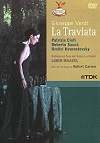 bed
as men pass by thrusting money at her.
With Alfredo as a society photographer,
and Germont looking like a company director,
the audience voice their disapproving
view at the end (review).
This La Fenice version is for the ultra
modernist only. Peter Hallís 1987 Glyndebourne
production presents a more traditional
view of the opera in opulent sets and
costumes by John Gunter. Maria McLaughlinís
emotionally searing Violetta is memorable.
Walter McNeil and Brent Ellis, like
her, are not international names but
the end-product represents the reality
of both the music and the drama of Verdiís
La Traviata. The performance
was filmed without audience and with
added sound effects (Arthaus Musik 100
112). When I saw the production on tour
in October 1988 it featured the then
25-year-old Roberto Alagna as Alfredo.
The tour was his debut in the role and
his tightly-focused, carefully controlled
and seamless tenor singing drew wide
praise.
bed
as men pass by thrusting money at her.
With Alfredo as a society photographer,
and Germont looking like a company director,
the audience voice their disapproving
view at the end (review).
This La Fenice version is for the ultra
modernist only. Peter Hallís 1987 Glyndebourne
production presents a more traditional
view of the opera in opulent sets and
costumes by John Gunter. Maria McLaughlinís
emotionally searing Violetta is memorable.
Walter McNeil and Brent Ellis, like
her, are not international names but
the end-product represents the reality
of both the music and the drama of Verdiís
La Traviata. The performance
was filmed without audience and with
added sound effects (Arthaus Musik 100
112). When I saw the production on tour
in October 1988 it featured the then
25-year-old Roberto Alagna as Alfredo.
The tour was his debut in the role and
his tightly-focused, carefully controlled
and seamless tenor singing drew wide
praise.
A few years after the
glorious trio of Rigoletto, Il
Trovatore and La Traviata,
Verdi, when asked to name his own favourite
among his operatic compositions, is
said to have replied speaking as
an amateur, La Traviata, as a
professional, Rigoletto.
La Traviata is the probably the
best-loved opera in the Verdi canon,
notwithstanding that several of his
later operas surpass this great middle
period trio in terms of musical inventiveness
and sophistication. But only Aida
has ever approached that trio in
terms of popularity.
Continue
on page 2

